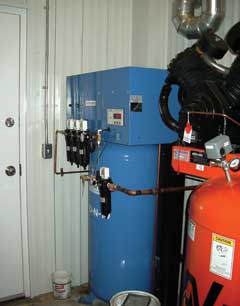

In either case, Nikiforuk points out, these costs are a mere fraction of what it costs to produce a cubic meter of nitrogen or oxygen from conventional sources: $3 to $15 for cylinders; $0.70 to $1.50 for liquid dewar; and $0.15 to $0.75 for bulk liquid.
“When comparing the costs of on-site gas for MAP applications versus conventional sources of gas supply, it becomes readily apparent why the ROI (return-on investment) for on-site MAP gas generating systems can typically be recouped in 18 months or less,” Nikiforuk states.
There is nothing inherently complicated about on-site gas generating technology, according to Nikiforuk: “It is simply an air-separation process.”
Air Support
Nikiforuk explains: “By passing a supply of compressed air through an on-site gas generating system, nitrogen or oxygen can be produced from atmospheric air.
“Normal breathable air is composed of 78-percent nitrogen and 21-percent oxygen, while the remaining one per cent is trace gas.
“Nitrogen molecules are much larger than oxygen molecules, and on-site technology uses the size difference between these two primary components of atmospheric air to separate them from each other.”
There are two main types of on-site gas generators available for capturing nitrogen or oxygen from air: pressure swing adsorption (PSA) systems for producing both nitrogen and oxygen; and membrane systems for producing nitrogen only.
The PSA-type generators have two pressure vessels that are filled with a material called “sieve.” Available in many different types, sieves consist of microscopically porous material with the ability to adsorb, under pressure, right down to the molecular level.
Producing nitrogen requires the use of a sieve material called CMS (carbon molecular sieve), Nikiforuk explains.
As a stream of compressed air is passed through a pressure vessel filled with CMS, the porous structure of CMS allows the material to capture and adsorb the smaller oxygen molecules—leaving a stream of nitrogen to flow out of the opposite end of the pressure vessel.
Advertisement

